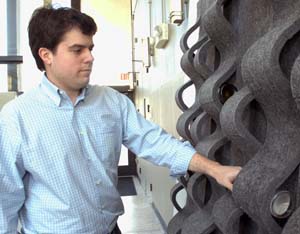Environmental discussions are often long on good intentions and short on specifics.
“I’m interested in sustainability, but I’m also interested in how it’s quantified,” says Kyle Thiel, who will receive his master’s of architecture May 16 from the Sam Fox School of Design & Visual Arts. “Take photovoltaic panels. What are their life cycle costs? What’s their payback? Do they increase the value of the project?

“Those arguments, more than global warming, will persuade developers. It’s a dollars-and-cents thing,” he says.
Thiel should know. Already a licensed architect, he spent six years practicing on the East Coast before coming to WUSTL. Much of his recent coursework, as well as his design projects, has delved into the difficult practicalities of green development.
“Kyle explores issues of sustainability from the urban scale all the way down to building design, materials and systems integrations,” says Bruce Lindsey, dean and the E. Desmond Lee Professor for Community Collaboration. “He really examines the full range of issues.”
Thiel was raised in Wichita, Kan., where his parents teach high-school chemistry and math. “Dad’s a woodworker; mom loves sewing and making quilts,” he says. “I think that sense of making things is what engaged me about architecture — the idea that ideas can be made concrete.”
After earning a bachelor’s degree from Kansas State University in 2000, Thiel worked for two firms in New Haven, Conn., where jobs included a New Haven high-school and a lab building for University of California, Los Angeles.
Yet Thiel missed academia and, in 2006, he arrived on the WUSTL campus. “I have aspirations to teach, so an advanced degree is necessary,” he says.
In his first semester, Thiel joined a regional planning studio that would win a national Education Honor Award from the American Institute of Architects. Co-sponsored by the University of Arkansas, the studio developed design proposals for mixed-use train stations at three sites in and around Fayetteville, Ark. The following spring, he worked on a hypothetical extension to the Kimball Art Museum in Fort Worth, Texas, and last fall designed a live-work tower — conceived as a kind of small-business incubator — for a site on the Chicago River just outside the Loop.
|
Sam Fox School of Design & Visual Arts, Graduate School of Architecture |
Yet, all the while, Thiel made a particular study of issues relating to development and sustainability and recently began building computer models to analyze how specific designs would function under real-world weather conditions. Indeed, such modeling helped shape his final thesis project: a two-story, 120,000-square-foot arts high school in rural Worden, Ill.
Spanning an existing freight rail line, the building consists of two long, narrow wings, slightly staggered and bridged by a crosspiece. Though the design incorporates “passive” conservation techniques — north-facing skylights, for example, would naturally light most classrooms — computer modeling allows Thiel to fine-tune for maximum efficiency.
“A particular type of wall construction gives me a certain R-value (a measure of thermal insulation), which in turn affects heating and cooling,” he says. Alternatively, “adding an extra six inches to the exterior envelope might cut HVAC usage by 20 percent,” he says.
Yet such calculations are complicated by the sheer number of variables in play. “You’ve got window systems, wall systems, roofing systems … it can be very difficult to make the case that a particular modification will equal a particular result. Developing clear, quantifiable rules-of-thumb is a real challenge,” he says.
It’s a challenge Thiel will face in earnest after graduation. Last month, he accepted a position with the St. Louis firm Cannon Design and begins work in June. Meanwhile — demonstrating green principles of conservation and restoration — Thiel and his wife, Heather, recently bought a 106-year-old brick house in
St. Louis’ Forest Park Southeast neighborhood.
“It’s a badge of honor for an architect to work on his own home,” Thiel says. “There are definitely some things I want to tear into. And the backyard is a bit of a mess, so my goal for the summer is to open up some usable ground space.”
When it comes to sustainability, “I’m trying to live it as well as preach it,” he says.